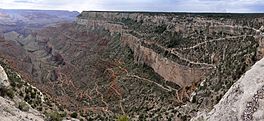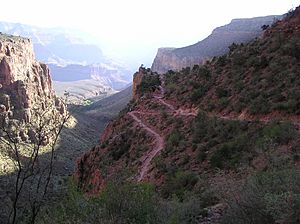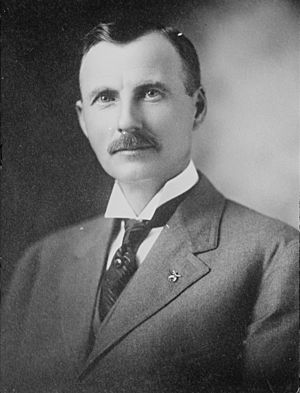Bright Angel Trail facts for kids
Quick facts for kids Bright Angel Trail |
|
|---|---|

Majority of the upper part of Bright Angel trail visible from the canyon rim.
|
|
| Length | 8.0 mi (12.9 km); 9.9 mi (15.9 km) to Phantom Ranch via River Trail |
| Location | Grand Canyon National Park, Arizona, United States |
| Trailheads | Phantom Ranch Grand Canyon (South Rim) |
| Use | Hiking |
| Elevation change | 4,380 ft (1,340 m) |
| Highest point | South Rim, 6,860 ft (2,090 m) |
| Lowest point | Colorado River, 2,480 ft (760 m) |
| Difficulty | Strenuous |
| Season | All year |
| Sights | Grand Canyon Colorado River |
| Hazards | Severe Weather Overexertion Dehydration |
The Bright Angel Trail is a famous hiking trail in Grand Canyon National Park in Arizona, United States. It's one of the most popular trails for exploring the Grand Canyon from the South Rim all the way down to the Colorado River.
Exploring the Bright Angel Trail
The Bright Angel Trail starts at Grand Canyon Village on the South Rim of the Grand Canyon. It goes down 4,380 feet (about 1,335 meters) to the Colorado River. The trail slopes down about 10% on average, which means it's quite steep!
At the end of the Bright Angel Trail, another path called the River Trail continues for about 1.9 miles (3.1 km). This leads to the Bright Angel Campground and Phantom Ranch. Many hikers and even mules use these trails to reach Phantom Ranch.
Trail Connections and Key Spots
The Bright Angel Trail connects with other trails along the way.
- The Tonto Trail crosses the Bright Angel Trail at a place called Indian Garden. From here, you can go west towards the Monument Use Area or east towards the South Kaibab Trail.
- The River Trail officially begins when the Bright Angel Trail reaches the Colorado River at the River Resthouse.
Here's a quick look at some important spots and distances along the trail:
| Distance (miles) | Elevation (feet) | Location | What's There |
|---|---|---|---|
| 0 | 6860 | Trailhead, South Rim | Where the trail begins, near the Rim Trail |
| 1.6 | 5729 | Mile-and-a-half Resthouse | A good spot to rest |
| 3.1 | 4748 | Three Mile Resthouse | Another rest stop |
| 4.9 | 3800 | Indian Garden | A green oasis, connects to Tonto Trail and Plateau Point Trail |
| 8.0 | 2480 | River Resthouse, Colorado River | The end of Bright Angel Trail, connects to River Trail |
| 9.5 | 2480 | Bright Angel Campground | A place to camp (via the River Trail) |
| 9.9 | 2546 | Phantom Ranch | A historic lodge and cabins (via the River Trail) |
Trail Condition and Maintenance
The Grand Canyon National Park calls the Bright Angel Trail a corridor trail. This means park rangers take good care of it. They regularly maintain the trail and patrol it to keep hikers safe.
Getting Water on the Trail
It's important to stay hydrated! Water is available at a few spots along the trail from a special pipeline. You can find water at:
- The Mile-and-a-half Resthouse
- The Three Mile Resthouse
- Indian Garden
During cooler months (usually October to April), the water at the two higher resthouses is turned off. This is to stop the pipes from freezing. Below Indian Garden, you can find natural water in Garden Creek and Pipe Creek all year. Water is also available from the Colorado River at the River Resthouse. Remember, any water from natural sources must be filtered, treated, or boiled before you drink it!
Camping Along the Trail
If you want to stay overnight, you can camp at Indian Garden Campground or Bright Angel Campground. You need a special permit from the Grand Canyon National Park Backcountry Information Center to camp. The park service manages how many people can camp at these sites to protect the environment.
You can ask for a permit up to four months before your trip. Permits are given out first-come, first-served.
Staying Safe on the Trail
Hiking the Bright Angel Trail is an amazing experience, but it's important to be aware of possible dangers. Some hazards include:
- Dehydration (not drinking enough water) or hyperhydration (drinking too much water too fast).
- Sudden rainstorms and flash floods.
- Loose footing, especially on icy patches in winter.
- Falling rocks.
- Encounters with wildlife.
- Extreme heat, especially in summer.
Near the Colorado River, be careful of:
- Hypothermia (getting too cold) because the river water is always very cold.
- Injuries from hitting rocks in the rapids if you go in the water.
- Drowning.
The trail is also used by mules that carry people and supplies. Mules always have the right of way, so step aside to let them pass safely. The trail has many sharp turns called switchbacks, so watch your step to avoid falls. Interestingly, squirrel bites at Plateau Point are a common cause of animal-related injuries to visitors!
History of the Trail
The Bright Angel Trail has a long and interesting history.
The Havasupai People
The upper part of this trail was first built by the Havasupai people. They used it to reach a reliable water source at what is now called Indian Garden. The Havasupai lived in this area seasonally. In 1903, President Theodore Roosevelt asked them to leave for the creation of a park. However, the last Havasupai families were not forced to leave by the National Park Service until 1928.
Ralph Cameron and His Tolls
Ralph H. Cameron came to the Grand Canyon in 1890. He later became a U.S. Senator for Arizona. Cameron started improving the old Havasupai trail. During this time, the trail was extended all the way to the Colorado River.
Once Cameron gained control of the trail, he named it the Bright Angel Trail. People often called it Cameron's Trail back then. He started charging a $1 fee to use the trail. He also charged extra for drinking water and outhouses at Indian Garden.
The Kolb Brothers' Photography Studio
Ellsworth Kolb arrived at the Grand Canyon in 1901 to work at the Bright Angel Hotel. His brother, Emery Kolb, joined him later. Emery bought a photography business for about $425 and moved it to the Grand Canyon.
The Kolb brothers started taking pictures of visitors riding mules down Cameron's trail. They charged a fee for these photos. They set up a tent studio nearby to develop and sell their pictures. Their business did very well! After a few years, the Kolb brothers built their permanent studio right on the rim of the canyon. They even blasted away rock to create the foundation for the building, which is still there today.
Ellsworth left the business in 1924, but Emery kept running the studio until he passed away in 1976. Today, the Kolb Studio is run by the Grand Canyon Association. It's a gift shop, an art studio, and a place to learn about the canyon's history.
New Trails and Park Control
To compete with Cameron's tolls, the Atchison, Topeka and Santa Fe Railway improved another trail called the Hermit Trail in 1911. Later, in 1924, the new National Park Service started building the South Kaibab Trail to give people another way to avoid Cameron's fees.
After many legal arguments, the Bright Angel Trail was finally given to the National Park Service in 1928. This meant everyone could use the trail without paying a private toll.
Images for kids










